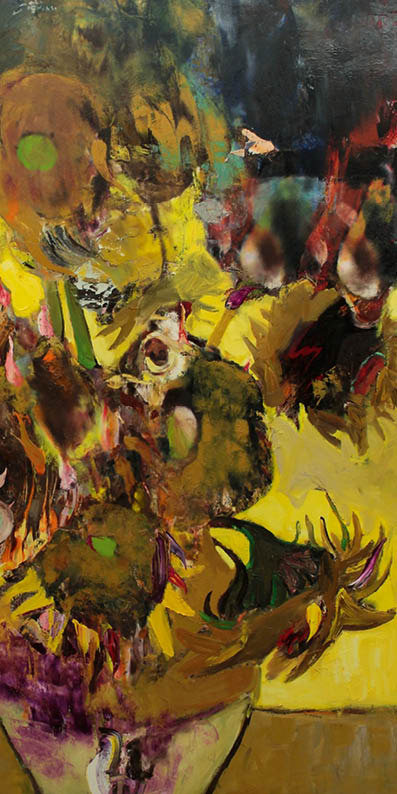Adrian Ghenie
dal 29/4/2014 al 27/6/2014
Segnalato da
29/4/2014
Adrian Ghenie
Galerie Judin, Berlin
Berlin Noir. Some of the works in this exhibition - consisting of nine paintings and one large-format work on paper - we encounter the sinister schemes of the Nazis and their henchmen.

Berlin Noir, the title of Adrian Ghenie’s third solo exhibition at Gallery Judin, is a reference to British author Philip Kerr’s popular trilogy of crime novels, in which his protagonist Bernhard Gunther, a private eye in 1930’s Berlin, plumbs the uncharted abysses of the human soul. And indeed, in some of the works in this exhibition—consisting of nine paintings and one large-format work on paper—we encounter the sinister schemes of the Nazis and their henchmen. Other works seem to, at least at first glance, have stumbled into the wrong century. The choice of motifs for the exhibition appears to be, mildly put, extremely heterogeneous. But those who have followed Ghenie’s breathtaking development since his first exhibitions in 2006 are unlikely to be confused by this tactic of telling stories through history, and from unexpected perspectives.
Berlin plays a special role in Adrian Ghenie’s life. In 2011 he finally made this city his home, both personally and professionally, after having worked here on and off for the last several years. Unlike many other artists, who appreciate Berlin for its low costs of living and the all-pervasive sense of excitement and innovation, Ghenie is attracted to its past. He calls it “the extra layer that this city has”, by which he is referring not only to its historicity and the visible traces of a century that brought this city, more than any other, its greatest triumphs and the most unfathomable suffering imaginable. Coming from Eastern Europe, he feels that Germans “understand” him, feels some kind of kinship rooted in a shared experience of dictatorship and a sense of collective tragedy. Most of all, Ghenie is fascinated by the fact that Germany, alone among the great centers of western culture had once renounced civilization, and instead turned to a modern form of barbarism. A people that at one time had produced painters such as Dürer and Friedrich, in the 20th century Germans were eliminating parts of the museum collections, and university professors were encouraging their students to burn books by Kästner, Freud and Tucholsky.
The images of those ecstatic students chanting their songs in the eerie glow of the pyres of burning books on the square in front of Berlin’s Humboldt University, are the point of departure for Ghenie’s engagement with this original sin of German cultural history. The painting Opernplatz (2014—like all the paintings in the exhibition) shows a bird’s eye view of what is today Bebelplatz, surrounded by the Staatsoper, University and St. Hedwig’s Cathedral. It is not, however, the book-burning that dominates the painting’s composition, but rather a dramatic sky with storm clouds and an overcast full moon. On the evening of the 10th of May 1937, it was pelting down rain in Berlin, such that the piled-up books could not be set ablaze but with the help of petrol. There was thus no celestial help in this “fight against all that is Un-German”, and this is what Ghenie might have had in mind when he painted this sky. The composition is reminiscent of the famous “Alexanderschlacht” (1592) by German renaissance Master Albrecht Altdorfer, in whose dramatic sky a rising sun symbolizes the just triumph of the (good) Greeks over the (barbaric) Persians. In an inverted paraphrase thereof, the bleak moon over the Opernplatz is shining a light on a new breed of barbarians.
The much smaller Burning Books describes the same event from the more conventional perspective of an eye-witness. Faceless onlookers are standing around the fire, burning paper swirling through the air. It is one of those moments in history that have, by way of black-and-white photography, indelibly etched themselves into our collective memories. Rendering this barbarous act in color, the artist becomes capable of stripping away the soothing sense of temporal distance, thus giving the event an almost contemporary character.
Less famous than the public burning of “Un-German literature” is the destruction of those pieces of “degenerate art” that could not be sold off on international markets, which took place on the 20th of March 1939 in the yard of the fire station Lindenstraße in Berlin-Kreuzberg. Estimates vary between sources, but it is safe to assume that some 20.000 works of art were destroyed. For a painter, this is of course an even more unbearable thought than the burning of books, given the fact that most of them were irreplaceable originals. Vincent Van Gogh, at the beginning of the 1930s already well-represented in Germany’s private and public collections, was also designated a “degenerate” artist, but luckily his paintings were already very valuable, and could thus escape destruction. For the small-format portrait of Van Gogh, Degenerate Art, Ghenie once again draws on his collage-technique, in order to achieve a deconstructivist composition of the image. The face is literally composed of animal parts—bits of fur, fish bellies, flaps of skin—as is clearly visible in studies for this painting.
More on the web site www.galeriejudin.com
Press office:
David Ulrichs +49 (0)176 50330135 david@david-ulrichs.com
Opening: Wednesday, 30 April 6 - 9pm
Galerie Judin
Potsdamer Straße 83 (yard) 10785 Berlin
Tue - Sat, 11am - 6pm



